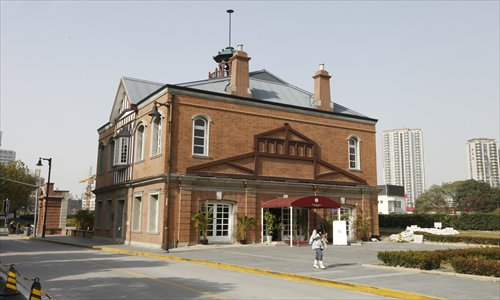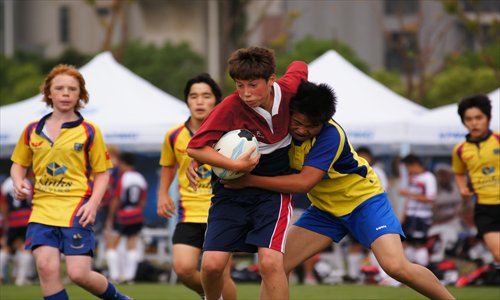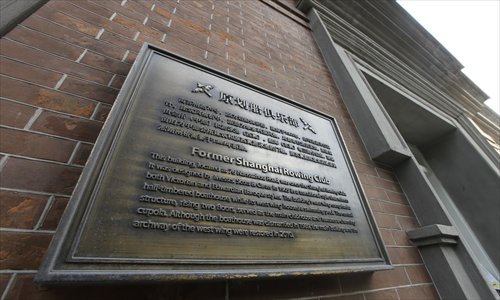HOME >> METRO SHANGHAI
Time to play
By Yang Zhenqi Source:Global Times Published: 2013-11-25 19:33:01

This concession-era building, once home to the Shanghai Rowing Club and now Shanghai Rose café bar, sits beside Suzhou Creek. Photo: Cai Xianmin/GT
From the late 19th century to the first half of 20th century hundreds of clubs, societies and associations thrived in Shanghai. Many of these groups, Chinese and foreign, were associated with sports. Over a century, most of these sports clubs vanished or disbanded but some have endured the tide of time and have blossomed in modern times in new incarnations.
The Shanghai Cricket Club
Shanghai's first official cricket match was in 1858 between a team of officers from HMS Highflyer (a 21-gun British frigate that saw action in the Opium Wars) and a Shanghai Eleven. The game, played somewhere in today's Hongkou district, saw the birth of the Shanghai Cricket Club.
In 1863 Shanghai's first true cricket ground came into being. The Shanghai Recreation Fund paid for land in the center of the racecourse from the Shanghai Race Club and turned it into a cricket ground surrounded by willow trees and flower gardens. The cricket ground was located at the corner of today's downtown Nanjing Road East and Jiangxi Road Middle.
The Shanghai Cricket Club played games with the Hong Kong Cricket Club and the Singapore Cricket Club from 1866 to 1948. Following a four-decade break after the founding of the People's Republic of China in 1949, the club was re-established in 1994 by expatriates living in Shanghai and has since attracted hundreds of new members.
Today the Shanghai Cricket Club runs a three-division league in which seven member clubs and associate teams play from April through October every year. The club has also hosted an invitational sixes tournament and played annual matches with Hong Kong, a revival of the original series.
The club's league matches are played on the grounds of the Shanghai Rugby Football Club in Waigaoqiao and Dulwich College in Jinqiao, both in Pudong New Area.

Junior players in action at the Shanghai Rugby Football Club. Photo: Cai Xianmin/GT
The Shanghai Rugby Football Club
The origins of the Shanghai Rugby Football Club can be traced back to 1867 when the very first Shanghai Football Club was founded, playing a hybrid of rugby and soccer on a field on the racecourse which became today's People's Square.
The first true rugby game (although a different form from the game played today) according to the club's website, was played in November 1875, five years after the first Shanghai Football Club had disbanded. Rugby player and historian Simon Drakeford observes that in those early days it seemed that the game to be played depended on the number of players who turned up. If enough turned up they would play rugby otherwise they would play association football.
However, as time went on, there was some friction between the adherents of the soccer and rugger codes and consequently, the Shanghai Rugby Football Club was born in September 1904. A surge of enthusiasm for rugby among expats (mainly Britons) in Shanghai at the time created an important sports tradition - the interport fixture.
The club's first interport match took place in Shanghai in February 1907 against a team from Tianjin and the teams met another seven times up to 1924. That year also marked the start of the most important and most enthusiastically attended interport annual fixture when Shanghai traveled to Hong Kong. The two teams played each other 15 times between 1924 and 1949.
In Shanghai, the club also welcomed the appearance of American, French and Japanese teams from the 1920s and the city's rugby scene flourished from then on until the liberation of Shanghai in 1949 when many players left Shanghai to return to their home countries.
The club struggled on and saw its final game of rugby played between club team and a "Retired Gentlemen" team in March 1950. Simon Drakeford notes: "At the request of the retirees the game was limited to two 20-minute halves. The result was not recorded but we do know that hot water would be provided but the players had to bring their own towel and soap."
Shanghai's rugby scene halted for some 45 years till the mid-1990s when games were played between groups of enthusiasts and the club was reborn. Today's Shanghai Rugby Football Club has evolved into a diverse sports club offering a dozen recreational and sporting activities including rugby, soccer, cricket, tennis and Frisbee involving the city's expats and local Chinese.

A plaque on the wall of the former rowing club outlines the building's history. Photo: Cai Xianmin/GT
The Shanghai Rowing Club
Set beside Suzhou Creek, a restored century-old red-brick building was once home to the Shanghai Rowing Club. The club was established by a group of British and American enthusiasts in 1860.
The club's autumn regatta, one of the sporting and social highlights of the year in Shanghai, was regularly held between the 1860s and the 1940s. After it was established the regatta moved to the Huangpu River and the annual event attracted competitors from the UK, the US, Germany, Denmark, Switzerland, Belgium, Norway and Japan.
The rowing club moved its headquarters to the building on Suzhou Creek in 1905. Designed by the prominent British architects, Scott & Carter, the Victorian and Edwardian styled building featured a large ballroom, dressing rooms, and a roof garden over the neighboring boathouse. The west wing of the clubhouse sported a swimming pool - one of Shanghai's first indoor pools.
In 1956, the club, whose members were mainly foreigners, was turned into the country's first water sports center by China's Sports Commission. In its heyday, the spacious, comprehensive center accommodated more than 1,000 athletes in Shanghai training for rowing, sailing and boating contests.
But in the following decades other more modern water sporting clubs and centers were being built around the city and the clubhouse fell into disuse. It was earmarked for demolition by the city government in 2009 but, after appeals from urban planning and architectural experts as well as some of the athletes who once trained at the club, the historic building was saved from the bulldozers and was restored to its original appearance in 2010.
Now protected as a cultural heritage site, the classic Shanghai concession-era building is home to Shanghai Rose, an upmarket café bar which opened early this year. The structure's impressive inside makeover was the brainchild of the Japanese artist Mika Ninagawa whose works are known for their use of vibrant colors. For the interior here she used red shades and tints.
Like the old rowing club before it, the two-story bar offers breathtaking views of the Huangpu River and the city's futuristic skyline.
The Shanghai Hongqiao Golf Club
Located at the city's western suburbs, the Hongqiao Golf Club was an exclusive sports and social club in Shanghai. It was opened in 1916, funded by eight of the foreign banks in Shanghai including Jardine Matheson and HSBC. Spreading out over 10 hectares the club offered first-rate golfing facilities and in 1930 expanded from its original nine holes to 18 holes, making it the first 18-hole golf course in Shanghai.
As the club swelled in popularity it became the ultimate meeting place to socialize, gamble or even play golf for the city's office workers and bank clerks. In an effort to curb the membership to less than 200 and keep its exclusivity the club board raised membership fees dramatically. By 1947 the monthly green fees cost 22,000 silver dollars, a fortune for most ordinary people even though inflation had reduced the value of the silver dollar. After the establishment of the People's Republic of China in 1949, the Hongqiao Golf Club was reclaimed by the city government and in 1953 it was turned into a public green space, Xijiao Park. It is now the Shanghai Zoo, one of the most eco-friendly parks in Shanghai, and home to more than 6,000 animals.
Compiled by Yang Zhenqi
Posted in: Metro Shanghai, Meeting up with old Shanghai